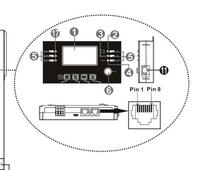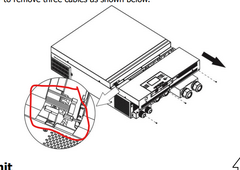fmeili1
Solar Enthusiast
Hi,
I'm trying to find a "clean" solution to remote shutdown my parallel EG4-6500EX AIO's (e.g. in case of an emergency).
I've already installed contactors/relays to shutdown the whole system by disconnecting all possible energy sources of the AIO's (AC-in, batteries and PV via Tigo PVRSS) in case of an emergency (e.g. smoke detector activation or pushing one of the emergency buttons or remote controlled by intention). Usually the AC-in contactor remains disconnected until I really need to use the grid to cover the power needs of the house (all of these disconnects could be controlled remotely via MQTT from a SmartHome system. Also all SA features are available in the SmartHome system for monitoring and controlling).
But I fear that if the AIO's are running as usual in inverter mode under high load it may not be good for the AIO's electronic components to suddenly just cut all sources of energy which will in fact be a "hard" shutdown for the AIO's.
Now I think about how to make such an emergency shutdown more friendly (soft) for the AIO's. After studying the AIO manual, the Modbus protocol manual and the SolarAssistant features, I was not able to find a clean solution so far.
First idea was to send an MQTT command via SA to switch to standby mode. But I've learned the EG4 Modbus protocol does not implemented such a feature, therefore it's not possible to be implemented in SA as well. Until now, it looks like that the AIO can only be switched to standby via releasing the power button manually by pressing it.
Second idea was (because of a hint in the SA power management automation description), to raise the program 29 setting (Low DC cut-off voltage) to a very high voltage to let the inverter detect suddenly a low voltage condition which would initiate immediately a shutdown (regarding the description in the manual). But unfortunately the highest voltage will be 48V for this setting. My batteriy voltage will usually always be over 48V but for this solution to function I need to set it e.g. to 60V to always trigger a shutdown via this low voltage cut-off feature. I'm not using closed loop communication and so I need to rely on voltages for this setting but anyway even with closed loop BMS communication I would not be able to set this value higher as 90% which would also not be enough to initiate an emergency shutdown because it have to work even if the batteries are at 100% SOC.
Third idea was to limit the "Maximum discharging current" to zero with program 41 to stop energy usage from the batteries, but the lowest possible value for this program is 30A.
Fourth idea was to play around with program 1 "Output source priority". Usually my system runs always in "SBU" mode. So I thought about the following scenario in case an emergency shutdown would happen:
But I still hope for a better solution...
Maybe someone will have other ideas...
I'm trying to find a "clean" solution to remote shutdown my parallel EG4-6500EX AIO's (e.g. in case of an emergency).
I've already installed contactors/relays to shutdown the whole system by disconnecting all possible energy sources of the AIO's (AC-in, batteries and PV via Tigo PVRSS) in case of an emergency (e.g. smoke detector activation or pushing one of the emergency buttons or remote controlled by intention). Usually the AC-in contactor remains disconnected until I really need to use the grid to cover the power needs of the house (all of these disconnects could be controlled remotely via MQTT from a SmartHome system. Also all SA features are available in the SmartHome system for monitoring and controlling).
But I fear that if the AIO's are running as usual in inverter mode under high load it may not be good for the AIO's electronic components to suddenly just cut all sources of energy which will in fact be a "hard" shutdown for the AIO's.
Now I think about how to make such an emergency shutdown more friendly (soft) for the AIO's. After studying the AIO manual, the Modbus protocol manual and the SolarAssistant features, I was not able to find a clean solution so far.
First idea was to send an MQTT command via SA to switch to standby mode. But I've learned the EG4 Modbus protocol does not implemented such a feature, therefore it's not possible to be implemented in SA as well. Until now, it looks like that the AIO can only be switched to standby via releasing the power button manually by pressing it.
Second idea was (because of a hint in the SA power management automation description), to raise the program 29 setting (Low DC cut-off voltage) to a very high voltage to let the inverter detect suddenly a low voltage condition which would initiate immediately a shutdown (regarding the description in the manual). But unfortunately the highest voltage will be 48V for this setting. My batteriy voltage will usually always be over 48V but for this solution to function I need to set it e.g. to 60V to always trigger a shutdown via this low voltage cut-off feature. I'm not using closed loop communication and so I need to rely on voltages for this setting but anyway even with closed loop BMS communication I would not be able to set this value higher as 90% which would also not be enough to initiate an emergency shutdown because it have to work even if the batteries are at 100% SOC.
Third idea was to limit the "Maximum discharging current" to zero with program 41 to stop energy usage from the batteries, but the lowest possible value for this program is 30A.
Fourth idea was to play around with program 1 "Output source priority". Usually my system runs always in "SBU" mode. So I thought about the following scenario in case an emergency shutdown would happen:
- Activate AC-in contactors to prepare using the "USB" mode
- Set AIO's to "USB" mode (via SA and MQTT commands) and wait until all changed to "Grid" mode
- Disconnect the batteries from the AIO's via the battery relays
- Disconnect the PV energy by initiating a PVRSS via Tigo
- Now disconnect AC-in via the contactors
But I still hope for a better solution...
Maybe someone will have other ideas...




